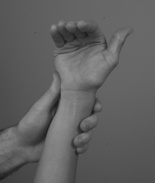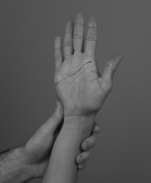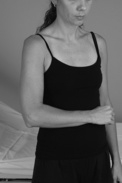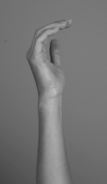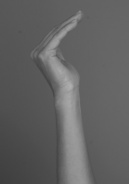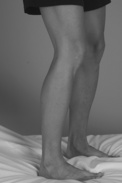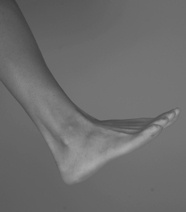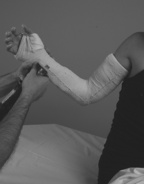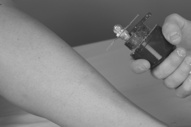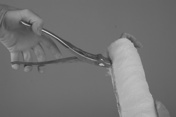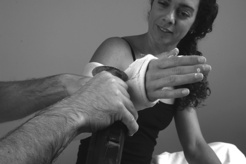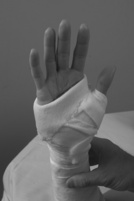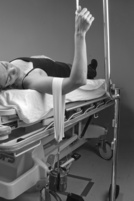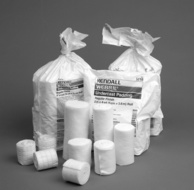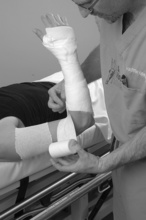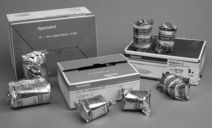Chapter 12 Basics of Splinting and Casting
Basic principles
First, Do No Harm
1. Make sure that the potential complications of applying and maintaining a cast or splint are less severe and less likely than the complications of an untreated injury.
2. A poorly made splint/cast can result in pressure sores, compression neuropathies, joint stiffness, and complex regional pain syndrome.
3. Never place a circumferential rigid dressing (cast) over an increasingly edematous limb because compartment syndrome can result.
4. Elastic bandages such as an all cotton elastic (ACE) bandage should be applied loosely so that the elasticity can accommodate any future swelling.
5. Elbows, forearms, and the lower leg and foot have the highest risk of compartment syndrome after cast application. Use caution when applying a cast in the acute setting.
6. Because plaster can expand, it is better to use plaster rather than the more rigid fiberglass cast in the acute setting.
What to Immobilize
1. For intraarticular or periarticular fractures, the bone proximal and distal to the joint involved should be included (one above and one below).
3. Immobilizing more joints than is necessary can result in permanent iatrogenic loss of joint motion.
4. Immobilization of fewer joints than is necessary can result in fracture displacement, neurovascular injury, and unnecessary pain and suffering.
5. Examples of correct immobilization:
a. Wrist fracture (distal radius):
(1) Bone above = the radius; begin the cast/splint above the elbow to prevent forearm (radial) rotation at the wrist.
b. Tibial shaft fracture:
(1) Joint above = the knee; begin the cast/splint as high up the leg as possible to limit knee motion.
What Position to Immobilize
1. Unless a pressing reason exists to do otherwise, each joint should be immobilized in the optimal position to retain joint mobility after the cast/splint is removed.
2. Specific positions:
e. Hand: intrinsic plus (metaphalangeal joints in at least 70 degrees of flexion and interphalangeal joints in extension) (Figure 12-6)
Bivalving
1. If a cast is placed in the acute setting and edema is a concern, the cast can be split longitudinally along two sides (bivalving).
3. Split the cast in a way such that divergence of the two cast “halves” does not compromise fracture reduction. For example, for distal radius fractures, split the cast directly dorsally and volarly (Figures 12-9 and 12-10).
Wedging
1. If the fracture reduction is acceptable in translation but not in angulation, the cast can be cut transversely on the acute angle of the malreduction and a wedge inserted to change the angle of the cast (Figure 12-11).
2. Because it is difficult to calculate the size of the wedge, it is best to apply a temporary wedge while radiographs are taken, followed by definitive wedge placement. Tongue depressors can be used as temporary wedges (Figure 12-12).
Cast Removal
1. Overview
a. A cast saw is an oscillating saw designed to cut hard cast material while minimizing trauma to soft material, such as cotton padding and skin.
c. Plaster casts can be unraveled after they are soaked in water for several minutes; however, finding the leading end of the plaster strip can be difficult.
d. Do not attempt to place any cast if a cast saw is not available, because emergent removal or trimming of the cast may be necessary.
e. A cast spreader can be very helpful in separating the two halves of a cast after they have been split (Figure 12-18).
f. We recommend that a cast saw be attached to suction to limit the volume of aerosolized particulate debris on clothes and in your lungs (Figure 12-19).
2. Technique
b. The cast saw should be pushed directly down into the cast (Figure 12-20). Your index finger should rest on the cast to limit the excursion of the cast saw.
Materials
Stockinette
2. Stockinettes may be used as a border to provide a more finished appearance to casts (Figure 12-21).
Cast Padding
1. Cast padding is available in cotton, synthetic, and waterproof varieties and in sizes ranging from 1 to 6 inches (Figure 12-23).
2. We prefer the cotton variety of cast padding because it expands more evenly, is more comfortable, and is easier to work with compared with other varieties.
4. Avoid placing a seam of cast padding or too much padding material on the flexion side of a joint, because pressure ulcers can result (Figure 12-24).
5. Avoid wrinkles and creases in the cast padding, which can result in pressure ulcers (Figure 12-25).
Plaster
3. We prefer Gypsona because it has a high plaster content, makes a nice, smooth finish on the outside, and feels silky to apply.
5. Plaster holds a mold better than fiberglass does and is the material of choice when a reduction is required.
9. Avoid air pockets or bubbles in the plaster, which form a stress riser inside the cast and lead to structural failure.
10. Avoid direct contact between the skin and plaster, which can result in abrasions and lacerations.
Fiberglass
1. Fiberglass is available in a variety of sizes and colors ranging from 1 to 6 inches and from hot pink to army green (Figure 12-27).
2. Fiberglass takes just a few minutes to reach near full structural integrity and is more resistant to deformation than is plaster. Because of these qualities, molding with fiberglass is much more difficult than molding with plaster.
3. Water does not compromise a fiberglass cast, and waterproof cast padding can be used if a patient intends to go in the water or if it is suspected he or she will do so.
6. Be sure to wring out any excess moisture from the fiberglass after activating it in water to prevent maceration of the cast padding.
Stay updated, free articles. Join our Telegram channel

Full access? Get Clinical Tree


